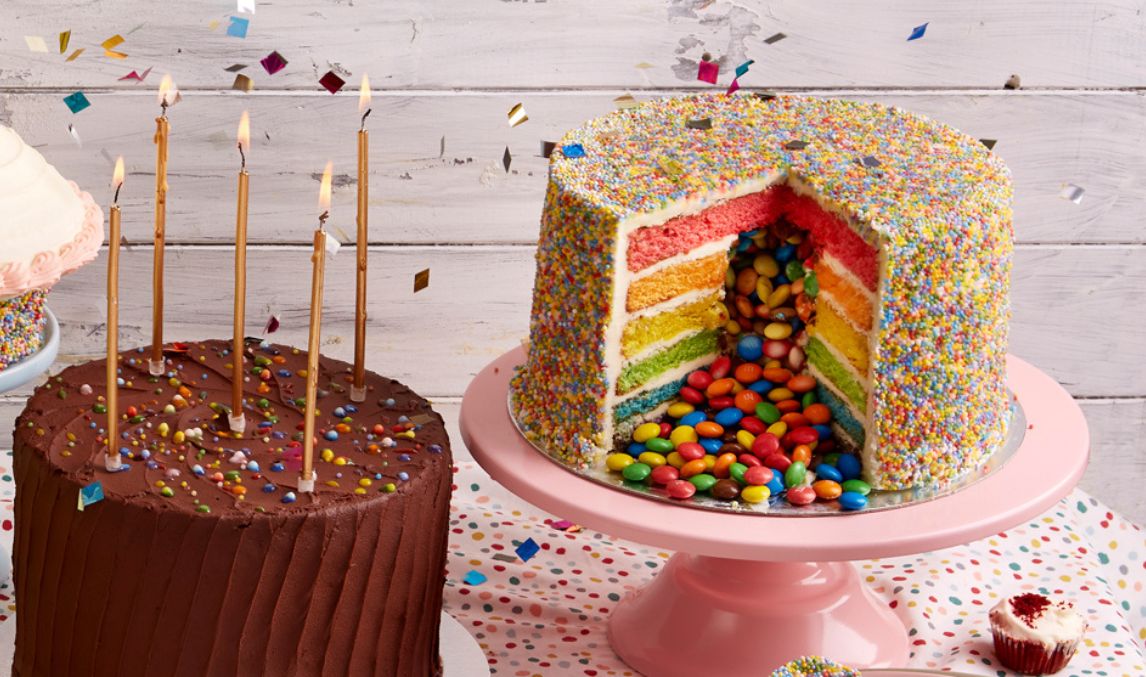Cake storage tips

WHEN PROPERLY STORED, CAKES KEEP WELL IN THE KITCHEN CUPBOARD, FRIDGE OR FREEZER, BUT HOW WELL THEY KEEP WILL DEPEND ON A NUMBER OF FACTORS. HERE ARE A FEW THINGS TO REMEMBER WHEN SAVING YOUR CAKES FOR ANOTHER DAY.
Serving your cakes
We think fresh baking tastes best, so we recommend eating your cakes within 24 hours of making them. Cakes are perishable and should be eaten as soon as possible if they contain wet ingredients like fresh fruit, fruit compotes or fresh dairy like cream, cream cheese, mascarpone or custard.
Cover your sponges
We cover our sponges completely with frosting as this helps to keep sponges from losing moisture. If you have piped frosting onto your cake or left sponge exposed, this is more likely to go dry in storage.
Wrapping your cakes
Always wrap sponges, cupcakes or cake slices well in cling film. This is to create a protective barrier and to prevent them from drying out. Ensure all cut sides are completely covered to prevent the sponge from going dry.
If keeping at room temperature, a cake tin lined with greaseproof paper is ideal for buttercream-topped cakes.

Refrigerating your cakes
Kept in the fridge, cake with buttercream or ganache topping will last for 3-4 days. If the cake has custard, cream, cream cheese or fresh fruit it will last 1-2 days at most.
If your cake has cream cheese frosting, we don’t recommend this is kept at room temperature, refrigerate for 1-2 days at most and then allow to come up to room temperature before serving.
Fruit cakes encased in marzipan and icing will last much longer.
Avoid refrigerating cakes with sugarpaste, fondant or food colouring as colours can bleed.
Freezing your cakes
Cakes freeze very well for up to 4 months. It’s best to wrap the sponges separately and to put the frosting in an airtight container before freezing.
For cake that is already frosted, wrap well in cling film, either whole or by the slice, and place in an airtight plastic container or airtight resealable bag. This will prevent it from absorbing flavours from the freezer.
You can also wrap a foil layer around the cling film to protect the cakes. Make sure there is plenty of space on your freezer shelf so that the cakes aren’t squished.
We don’t recommend freezing meringue or cream-based icings as these can spoil.
Defrosting your cakes
Take your cakes out of the freezer and allow to defrost completely before serving.
Take your frosting out of the freezer and add a splash of milk and whip for a few minutes once defrosted to make the frosting fluffy and spreadable.
If you wish to level your sponges before layering, this should be done after the sponges have defrosted with a serrated knife.
Sunlight
Keep your cakes out of direct sunlight as this can both melt the frosting and discolour your icing if it is coloured.

Temperature
Keep your cakes cool or at room temperature. Heat will cause frosting to melt and slide and it dries out the sponge.
In summer, or if your kitchen is very warm, it is better to refrigerate your cakes and then allow to come up to room temperature if you plan to serve them at a later time.
Soggy bottoms
Humidity either from the environment or from the warm cakes as they cool can lead to peeling cupcake cases or soggy sponges. Allow cakes to cool completely on a wire cooling rack before frosting and storing to allow moisture to evaporate first.
Test your batch
If baking in advance for a big occasion, we recommend batch testing your cake ahead of the event for freezing suitability.
A good trick is to test half when the cake is fresh so you have a guide for how the cake should taste and then freeze or refrigerate the second half to test how it will fare. This is also an excuse for double the cake!

Freezing cookies
Cookie dough freezes perfectly for up to 4 months or will keep in the fridge for up to 2 days. You can throw the whole dough ball in the freezer wrapped well in cling film or, to make life easier, roll it into a log and wrap well with cling film before freezing.
Slice with a hot knife into rounds straight from the freezer before baking. Increase your baking time by a few extra minutes and keep an eye on it to compensate for the lower temperature of the dough.
Storing cookies
Place squares of greaseproof paper between the cookies and keep in an airtight container. You can always refresh cookies by sprinkling with a few drops of water and placing in a hot oven for a few minutes to restore their chewiness.
Rescue stale cake
If your cake has gone stale, all is not lost. Whizz the sponge up in a food processor and sprinkle as crumb decorations on a fresh batch, stir up with frosting and roll into balls chilled and dipped in chocolate to make cake pops or crumble over ice cream (one of our favourite cheeky ways to enjoy leftover Red Velvet).
